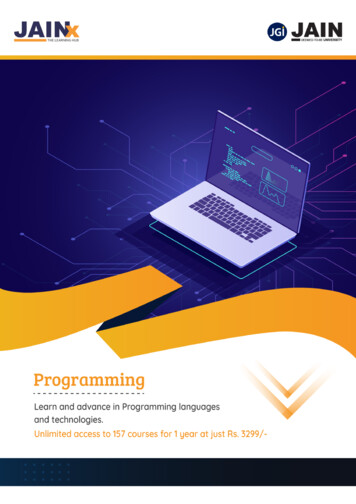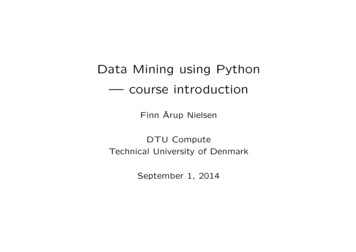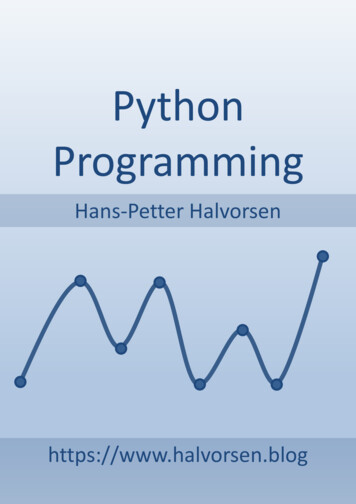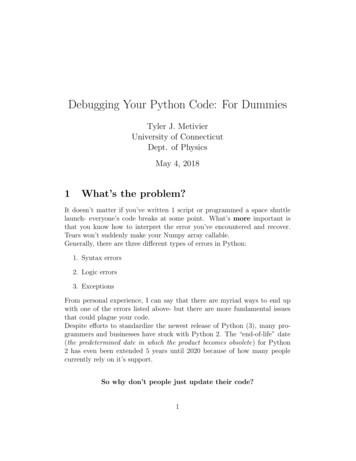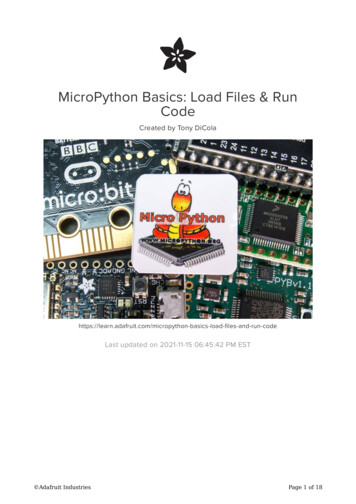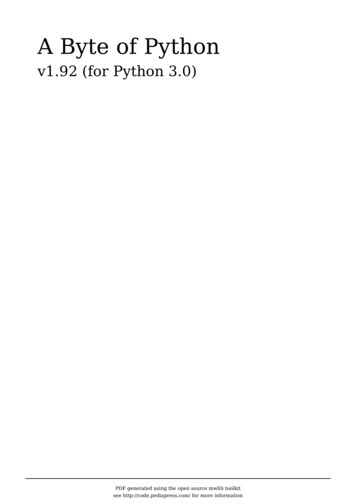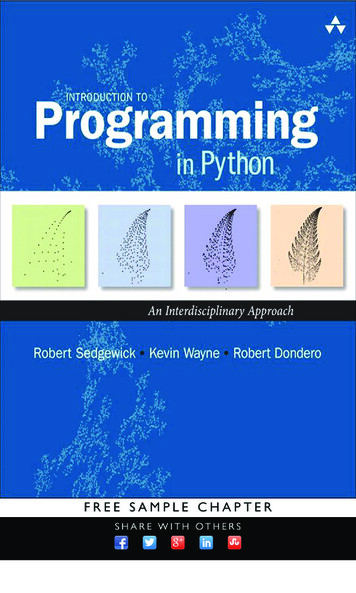
Transcription
IntroductiontoProgramming in Python
This page intentionally left blank
IntroductiontoProgramming in PythonAn Interdisciplinary ApproachRobert SedgewickKevin WayneRobert DonderoPrinceton UniversityNew York Boston Indianapolis San FranciscoToronto Montreal London Munich Paris MadridCapetown Sydney Tokyo Singapore Mexico City
Many of the designations used by manufacturers and sellers to distinguish their products are claimedas trademarks. Where those designations appear in this book, and the publisher was aware of a trademark claim, the designations have been printed with initial capital letters or in all capitals.The authors and publisher have taken care in the preparation of this book, but make no expressedor implied warranty of any kind and assume no responsibility for errors or omissions. No liability isassumed for incidental or consequential damages in connection with or arising out of the use of theinformation or programs contained herein.For information about buying this title in bulk quantities, or for special sales opportunities (whichmay include electronic versions; custom cover designs; and content particular to your business, training goals, marketing focus, or branding interests), please contact our corporate sales department atcorpsales@pearsoned.com or (800) 382-3419.For government sales inquiries, please contact governmentsales@pearsoned.com.For questions about sales outside the United States, please contact international@pearsoned.com.Visit us on the Web: informit.com/awLibrary of Cataloging-in-Publication DataSedgewick, Robert, 1946Introduction to programming in Python : an interdisciplinary approach / Robert Sedgewick, KevinWayne, Robert Dondero.pages cmIncludes indexes.ISBN 978-0-13-407643-0 (hardcover : alk. paper)—ISBN 0-13-407643-51. Python (Computer program language) 2. Computer programming. I. Wayne, Kevin Daniel, 1971II. Dondero, Robert. III. Title.QA76.73.P98S43 2015005.13'3—dc232015011936Copyright 2015 Pearson Education, Inc.All rights reserved. Printed in the United States of America. This publication is protected by copyright,and permission must be obtained from the publisher prior to any prohibited reproduction, storage ina retrieval system, or transmission in any form or by any means, electronic, mechanical, photocopying, recording, or likewise. To obtain permission to use material from this work, please submit a written request to Pearson Education, Inc., Permissions Department, 200 Old Tappan Road, Old Tappan,New Jersey 07675, or you may fax your request to 236-3290.ISBN-13: 978-0-13-407643-0ISBN-10: 0-13-407643-5Text printed in the United States on recycled paper at Edwards Brothers Malloy in Ann Arbor,Michigan.First printing, June 2015
To Adam, Andrew, Brett, Robbie,Henry, Iona, Rose, Peter,and especially LindaTo Jackie and AlexTo my family,especially Ellen and Meghan
This page intentionally left blank
ContentsPreface . . . . . . . . . . . . . . . . . . . . xiii1—Elements of Programming . . . . . . . . . . . . 11.1 Your First Program21.2 Built-in Types of Data141.3 Conditionals and Loops561.4 Arrays1001.5 Input and Output1401.6 Case Study: Random Web Surfer1882—Functions and Modules . . . . . . . . . . . . 2092.1 Defining Functions2102.2 Modules and Clients2482.3 Recursion2902.4 Case Study: Percolation3223—Object-Oriented Programming . . . . . . . . .3.1 Using Data Types3523.2 Creating Data Types4023.3 Designing Data Types4503.4 Case Study: N-Body Simulation4963514—Algorithms and Data Structures . . . . . . . . . 5114.1 Performance5124.2 Sorting and Searching5564.3 Stacks and Queues5904.4 Symbol Tables6344.5 Case Study: Small-World Phenomenon684Context . . . . . . . . . . . . . . . . . . .729Glossary . . . . . . . . . . . . . . . . . . . 733Index . . . . . . . . . . . . . . . . . . . .739
This page intentionally left blank
ProgramsProgramsixElements of Programming1.1Your First .3.51.3.61.3.71.3.81.3.9Flipping a fair coin . . . . . . . 59Your first loop . . . . . . . . . 62Computing powers of 2 . . . . . 64Your first nested loops . . . . . 70Harmonic numbers . . . . . . 73Newton’s method . . . . . . . 75Converting to binary. . . . . . . 77Gambler’s ruin simulation . . . . 79Factoring integers . . . . . . . amProgram1.5.1 Generating a random sequence . 1421.5.2 Interactive user input. . . . . . 1501.5.3 Averaging a stream of numbers . 1521.5.4 A simple filter. . . . . . . . . 1561.5.5 Standard input to drawing filter .1621.5.6 Function graph . . . . . . . . 1641.5.7 Bouncing ball. . . . . . . . . 1691.5.8 Digital signal processing . . . . 174Case Study: Random Web ogram2.31.6.1 Computing the transition matrix. 1911.6.2 Simulating a random surfer . . . 1931.6.3 Mixing a Markov chain. . . . . 2002.1.12.1.22.1.32.1.4Harmonic numbers (revisited) . 213Gaussian functions. . . . . . . 223Coupon collector (revisited) . . . 225Play that tune (revisited) . . . . 234Modules and aussian functions module. . . . 250Sample Gaussian client . . . . . 251Random number module. . . . 261Iterated function systems . . . . 269Data analysis module . . . . . . 272Plotting data values . . . . . . . 275Bernoulli trials . . . . . . . . Sampling without replacement . 113Coupon collector simulation . . . 117Sieve of Eratosthenes. . . . . . 119Self-avoiding random walks . . 128Input and OutputProgram1.6String concatenation example . . . 23Integer operators . . . . . . . . 26Float operators . . . . . . . . 29Quadratic formula. . . . . . . . 31Leap year . . . . . . . . . . . g FunctionsProgramConditionals and LoopsProgram1.411.1.1 Hello, World . . . . . . . . . . 41.1.2 Using a command-line argument . 7Built-in Types of DataProgram1.3Functions and Modules2.3.12.3.22.3.32.3.42.3.5Euclid’s algorithm . . . . . . . 295Towers of Hanoi . . . . . . . . 298Gray code . . . . . . . . . . . 303Recursive graphics. . . . . . . 305Brownian bridge. . . . . . . . 307Case Study: ramProgram2.4.1 Percolation scaffolding . . . . . 3262.4.2 Vertical percolation detection. . . 3282.4.3 Percolation input/output . . . . 3302.4.4 Visualization client . . . . . . . 3312.4.5 Percolation probability estimate .3332.4.6 Percolation detection . . . . . . 3352.4.7 Adaptive plot client . . . . . . . 338
Object-Oriented Programming3.1Data .2.43.2.53.2.63.2.73.2.8Charged particle . . . . . . . . 409Stopwatch . . . . . . . . . . 413Histogram . . . . . . . . . . 415Turtle graphics . . . . . . . . 418Spira mirabilis . . . . . . . . 421Complex numbers. . . . . . . 427Mandelbrot set . . . . . . . . 431Stock account. . . . . . . . . .3.43.3.5Complex numbers (polar). . . . 456Counter . . . . . . . . . . . 459Spatial vectors . . . . . . . . . 466Document sketch . . . . . . . 483Similarity detection . . . . . . 485Case Study: N-Body SimulationProgramProgram3.4.13.4.2Gravitational body . . . . . . . 500N-body simulation. . . . . . . gramProgramBinary search (20 questions). . . 558Bisection search . . . . . . . . 562Binary search (in a sorted array) .565Insertion sort . . . . . . . . . 569Doubling test for sorts . . . . . 571Mergesort . . . . . . . . . . . 574Frequency counts . . . . . . . 5794.3.14.3.24.3.34.3.44.3.54.3.6Stack (resizing array) . . . . . . 594Stack (linked list). . . . . . . . 598Expression evaluation . . . . . . 605FIFO queue (linked list) . . . . . 609M/M/1 queue simulation . . . . 615Load-balancing simulation . . . 618Symbol .34.2.44.2.54.2.64.2.7Stacks and QueuesProgram4.44.1.1 3-sum problem . . . . . . . . 5154.1.2 Validating a doubling hypothesis .517Sorting and SearchingProgramDesigning Data TypesProgram3.4Identifying a potential gene . . . 359Charged-particle client . . . . . 363Albers squares . . . . . . . . . 368Luminance module . . . . . . . 370Converting color to grayscale. . . 374Image scaling . . . . . . . . . 376Fade effect . . . . . . . . . . 377Visualizing electric potential . . . 379Concatenating files. . . . . . . 383Screen scraping for stock quotes .385Splitting a file . . . . . . . . 387Creating Data 3.1.83.1.93.1.103.1.11Algorithms and Data Structures4.4.14.4.24.4.34.4.4Dictionary lookup. . . . . . . 641Indexing . . . . . . . . . . 643Hash table . . . . . . . . . . 649Binary search tree . . . . . . . 656Case Study: Small-World am4.5.14.5.24.5.34.5.44.5.54.5.6Graph data type . . . . . . . . 691Using a graph to invert an index .695Shortest-paths client . . . . . . 699Shortest-paths implementation .705Small-world test. . . . . . . . 710Performer–performer graph . . . 712
This page intentionally left blank
This page intentionally left blank
PrefaceThe basis for education in the last millennium was “reading, writing, and arithmetic”; now it is reading, writing, and computing. Learning to program is anessential part of the education of every student in the sciences and engineering.Beyond direct applications, it is the first step in understanding the nature of computer science’s undeniable impact on the modern world. This book aims to teachprogramming to those who need or want to learn it, in a scientific context.Our primary goal is to empower students by supplying the experience andbasic tools necessary to use computation effectively. Our approach is to teach students that composing a program is a natural, satisfying, and creative experience.We progressively introduce essential concepts, embrace classic applications fromapplied mathematics and the sciences to illustrate the concepts, and provide opportunities for students to write programs to solve engaging problems.We use the Python programming language for all of the programs in thisbook—we refer to “Python” after “programming in the title to emphasize the ideathat the book is about fundamental concepts in programming, not Python per se.This book teaches basic skills for computational problem solving that are applicable in many modern computing environments, and is a self-contained treatmentintended for people with no previous experience in programming.This book is an interdisciplinary approach to the traditional CS1 curriculum,in that we highlight the role of computing in other disciplines, from materials science to genomics to astrophysics to network systems. This approach emphasizesfor students the essential idea that mathematics, science, engineering, and computing are intertwined in the modern world. While it is a CS1 textbook designed forany first-year college student interested in mathematics, science, or engineering,the book also can be used for self-study or as a supplement in a course that integrates programming with another field.xiii
CoverageThe book is organized around four stages of learning to program:basic elements, functions, object-oriented programming, and algorithms . We provide the basic information readers need to build confidence in composing programs at each level before moving to the next level. An essential feature of ourapproach is to use example programs that solve intriguing problems, supportedwith exercises ranging from self-study drills to challenging problems that call forcreative solutions.Basic elements include variables, assignment statements, built-in types of data,flow of control , arrays, and input/output, including graphics and sound.Functions and modules are the student’s first exposure to modular programming. We build upon familiarity with mathematical functions to introduce Pythonfunctions, and then consider the implications of programming with functions, including libraries of functions and recursion. We stress the fundamental idea ofdividing a program into components that can be independently debugged, maintained, and reused.Object-oriented programming is our introduction to data abstraction. We emphasize the concepts of a data type and their implementation using Python’s classmechanism. We teach students how to use, create, and design data types. Modularity, encapsulation, and other modern programming paradigms are the centralconcepts of this stage.Algorithms and data structures combine these modern programming paradigms with classic methods of organizing and processing data that remain effectivefor modern applications. We provide an introduction to classical algorithms forsorting and searching as well as fundamental data structures and their application,emphasizing the use of the scientific method to understand performance characteristics of implementations.Applications in science and engineering are a key feature of the text. We motivate each programming concept that we address by examining its impact on specific applications. We draw examples from applied mathematics, the physical andbiological sciences, and computer science itself, and include simulation of physicalsystems, numerical methods, data visualization, sound synthesis, image processing, financial simulation, and information technology. Specific examples include atreatment in the first chapter of Markov chains for web page ranks and case studies that address the percolation problem, n-body simulation, and the small-worldphenomenon. These applications are an integral part of the text. They engage students in the material, illustrate the importance of the programming concepts, andxiv
provide persuasive evidence of the critical role played by computation in modernscience and engineering.Our primary goal is to teach the specific mechanisms and skills that are needed to develop effective solutions to any programming problem. We work with complete Python programs and encourage readers to use them. We focus on programming by individuals, not programming in the large.Use in the CurriculumThis book is intended for a first-year college courseaimed at teaching novices to program in the context of scientific applications.Taught from this book, prospective majors in any area of science and engineeringwill learn to program in a familiar context. Students completing a course based onthis book will be well prepared to apply their skills in later courses in science andengineering and to recognize when further education in computer science mightbe beneficial.Prospective computer science majors, in particular, can benefit from learningto program in the context of scientific applications. A computer scientist needs thesame basic background in the scientific method and the same exposure to the roleof computation in science as does a biologist, an engineer, or a physicist.Indeed, our interdisciplinary approach enables colleges and universities toteach prospective computer science majors and prospective majors in other fieldsof science and engineering in the same course. We cover the material prescribed byCS1, but our focus on applications brings life to the concepts and motivates students to learn them. Our interdisciplinary approach exposes students to problemsin many different disciplines, helping them to choose a major more wisely.Whatever the specific mechanism, the use of this book is best positioned earlyin the curriculum. First, this positioning allows us to leverage familiar materialin high school mathematics and science. Second, students who learn to programearly in their college curriculum will then be able to use computers more effectivelywhen moving on to courses in their specialty. Like reading and writing, programming is certain to be an essential skill for any scientist or engineer. Students whohave grasped the concepts in this book will continually develop that skill through alifetime, reaping the benefits of exploiting computation to solve or to better understand the problems and projects that arise in their chosen field.xv
Prerequisites This book is suitable for typical science and engineering studentsin their first year of college. That is, we do not expect preparation beyond what istypically required for other entry-level science and mathematics courses.Mathematical maturity is important. While we do not dwell on mathematicalmaterial, we do refer to the mathematics curriculum that students have taken inhigh school, including algebra, geometry, and trigonometry. Most students in ourtarget audience automatically meet these requirements. Indeed, we take advantage of their familiarity with the basic curriculum to introduce basic programmingconcepts.Scientific curiosity is also an essential ingredient. Science and engineering students bring with them a sense of fascination with the ability of scientific inquiry tohelp explain what goes on in nature. We leverage this predilection with examplesof simple programs that speak volumes about the natural world. We do not assumeany specific knowledge beyond that provided by typical high school courses inmathematics, physics, biology, or chemistry.Programming experience is not necessary, but also is not harmful. Teachingprogramming is our primary goal, so we assume no prior programming experience. But composing a program to solve a new problem is a challenging intellectualtask, so students who have written numerous programs in high school can benefitfrom taking an introductory programming course based on this book . The bookcan support teaching students with varying backgrounds because the applicationsappeal to both novices and experts alike.Experience using a computer is not necessary, but also is not at all a problem.College students use computers regularly, to communicate with friends and relatives, listen to music, to process photos, and as part of many other activities. Therealization that they can harness the power of their own computer in interestingand important ways is an exciting and lasting lesson.In summary, virtually all students in science and engineering fields are prepared to take a course based on this book as a part of their first-semester curriculum.xvi
Goals What can instructors of upper-level courses in science and engineeringexpect of students who have completed a course based on this book?We cover the CS1 curriculum, but anyone who has taught an introductoryprogramming course knows that expectations of instructors in later courses aretypically high: each instructor expects all students to be familiar with the computing environment and approach that he or she wants to use. A physics professormight expect some students to design a program over the weekend to run a simulation; an engineering professor might expect other students to be using a particularpackage to numerically solve differential equations; or a computer science professor might expect knowledge of the details of a particular programming environment. Is it realistic to meet such diverse expectations? Should there be a differentintroductory course for each set of students?Colleges and universities have been wrestling with such questions since computers came into widespread use in the latter part of the 20th century. Our answerto them is found in this common introductory treatment of programming, whichis analogous to commonly accepted introductory courses in mathematics, physics,biology, and chemistry. An Introduction to Programming in Python strives to provide the basic preparation needed by all students in science and engineering, whilesending the clear message that there is much more to understand about computerscience than programming. Instructors teaching students who have studied fromthis book can expect that they will have the knowledge and experience necessaryto enable those students to adapt to new computational environments and to effectively exploit computers in diverse applications.What can students who have completed a course based on this book expect toaccomplish in later courses?Our message is that programming is not difficult to learn and that harnessing the power of the computer is rewarding. Students who master the material inthis book are prepared to address computational challenges wherever they mightappear later in their careers. They learn that modern programming environments,such as the one provided by Python, help open the door to any computationalproblem they might encounter later, and they gain the confidence to learn, evaluate,and use other computational tools. Students interested in computer science will bewell prepared to pursue that interest; students in science and engineering will beready to integrate computation into their studies.xvii
BooksiteAn extensive amount of information that supplements this text maybe found on the web athttp://introcs.cs.princeton.edu/pythonFor economy, we refer to this site as the booksite throughout. It contains materialfor instructors, students, and casual readers of the book. We briefly describe thismaterial here, though, as all web users know, it is best surveyed by browsing. Witha few exceptions to support testing, the material is all publicly available.One of the most important implications of the booksite is that it empowers instructors and students to use their own computers to teach and learn thematerial. Anyone with a computer and a browser can begin learning to programby following a few instructions on the booksite. The process is no more difficultthan downloading a media player or a song. As with any website, our booksite iscontinually evolving. It is an essential resource for everyone who owns this book. Inparticular, the supplemental materials are critical to our goal of making computerscience an integral component of the education of all scientists and engineers.For instructors, the booksite contains information about teaching. This information is primarily organized around a teaching style that we have developedover the past decade, where we offer two lectures per week to a large audience,supplemented by two class sessions per week where students meet in small groupswith instructors or teaching assistants. The booksite has presentation slides for thelectures, which set the tone.For teaching assistants, the booksite contains detailed problem sets and programming projects, which are based on exercises from the book but contain muchmore detail. Each programming assignment is intended to teach a relevant conceptin the context of an interesting application while presenting an inviting and engaging challenge to each student. The progression of assignments embodies our approach to teaching programming. The booksite fully specifies all the assignmentsand provides detailed, structured information to help students complete them inthe allotted time, including descriptions of suggested approaches and outlines forwhat should be taught in class sessions.For students, the booksite contains quick access to much of the material in thebook, including source code, plus extra material to encourage self-learning. Solutions are provided for many of the book’s exercises, including complete programcode and test data. There is a wealth of information associated with programmingassignments, including suggested approaches, checklists, FAQs, and test data.xviii
For casual readers , the booksite is a resource for accessing all manner of extrainformation associated with the book’s content. All of the booksite content provides web links and other routes to pursue more information about the topic underconsideration. There is far more information accessible than any individual couldfully digest, but our goal is to provide enough to whet any reader’s appetite formore information about the book’s content.Acknowledgments This project has been under development since 1992, sofar too many people have contributed to its success for us to acknowledge themall here. Special thanks are due to Anne Rogers, for helping to start the ball rolling;to Dave Hanson, Andrew Appel, and Chris van Wyk, for their patience in explaining data abstraction; and to Lisa Worthington, for being the first to truly relishthe challenge of teaching this material to first-year students. We also gratefully acknowledge the efforts of /dev/126 ; the faculty, graduate students, and teachingstaff who have dedicated themselves to teaching this material over the past 25 yearshere at Princeton University; and the thousands of undergraduates who have dedicated themselves to learning it.Robert SedgewickKevin WayneRobert DonderoApril 2015xix
Functions and Modules2.1 Defining FunctionsYou have been composing code that calls Python functions since the beginning ofthis book, from writing strings with stdio.writeln() to using type conversionfunctions such as str() and int() to computing mathematical functions suchas math.sqrt() to using all of the functions in stdio, stddraw, and stdaudio.2.1.1 Harmonic numbers (revisited). . . 213In this section, you will learn how to de2.1.2 Gaussian functions . . . . . . . . . 223fine and call your own functions.2.1.3 Coupon collector (revisited) . . . . 2252.1.4 Play that tune (revisited). . . . . . 234In mathematics, a function mapsan input value of one type (the domain)Programs in this sectionto an output value of another type (therange). For example, the square functionf (x) x 2 maps 2 to 4, 3 to 9, 4 to 16, and so forth. At first, we work with Pythonfunctions that implement mathematical functions, because they are so familiar.Many standard mathematical functions are implemented in Python’s math module,but scientists and engineers work with a broad variety of mathematical functions,which cannot all be included in the module. At the beginning of this section, youwill learn how to implement and use such functions on your own.Later, you will learn that we can do more with Python functions than implement mathematical functions: Python functions can have strings and other typesas their domain or range, and they can have side effects such as writing output. Wealso consider in this section how to use Python functions to organize programs andthereby simplify complicated programming tasks.From this point forward, we use the generic term function to mean either Python function or mathematical function depending on the context. We use the morespecific terminology only when the context requires that we do so.Functions support a key concept that will pervade your approach to programming from this point forward: Whenever you can clearly separate tasks withina computation, you should do so. We will be overemphasizing this point throughoutthis section and reinforcing it throughout the rest of the chapter (and the rest ofthe book). When you write an essay, you break it up into paragraphs; when youcompose a program, you break it up into functions. Separating a larger task intosmaller ones is much more important when programming than when writing anessay, because it greatly facilitates debugging, maintenance, and reuse, which are allcritical in developing good software.
2.1 Defining FunctionsUsing and defining functionsAs you know from the functions you have beenusing, the effect of calling a Python function is easy to understand. For example,when you place math.sqrt(a-b) in a program, the effect is as if you had replacedthat code with the return value that is produced by Python’s math.sqrt() functionwhen passed the expression a-b as an argument. This usage is so intuitive that wehave hardly needed to comment on it. If you think about what the system has todo to create this effect, however, you will see that it involves changing a program’scontrol flow. The implications of being able to change the control flow in this wayare as profound as doing so for conditionals and loops.You can define functions in any Python program, using the def statementthat specifies the function signature, followed by a sequence of statements thatconstitute the function. We will consider the details shortly, but begin with a simpleexample that illustrates how functions affect control flow. Our first example, Program 2.1.1 (harmonicf.py), includes a function named harmonic() that takes anargument n and computes the nth harmonic number (see Program 1.3.5). It alsoillustrates the typical structure of a Python program, having three components: A sequence of import statements A sequence of function definitions Arbitrary global code, or the body of the pro
Introduction to programming in Python : an interdisciplinary approach / Robert Sedgewick, Kevin Wayne, Robert Dondero. pages cm Includes indexes. ISBN 978-0-13-407643-0 (hardcover : alk. paper)—ISBN 0-13-407643-5 1. Python (Computer program language) 2. Computer programming. I. Wayne, Kevi





